Advances in Retrofitting Strategies for Energy Efficiency in Tropical Climates: A Systematic Review and Analysis
Abstract
:1. Introduction
2. Materials and Methods
2.1. Literature Search Strategy
- To gather as many studies as possible, the use of scientific databases such as Google Scholar, Science Direct, and Springer were selected.
- The search was performed in each of the scientific databases. The main co-word combinations and Boolean operators were retrofit AND building AND “energy efficiency”; retrofit AND building AND “energy efficiency” AND (NZEB OR nZEB); retrofit AND building; retrofit AND (NZEB OR nZEB), which returned a total of 34,553 documents.
- An exclusion criterion was applied, limiting the research to English and a period of the last five years (2018–2024) and using the Boolean operators, which returned a total of 16,649 documents.
- The papers were analyzed using a combination of additional co-word combinations and Boolean operators to include tropic/tropical climate/humid; the combinations were the following: retrofit AND building AND “energy efficiency” AND (tropics OR “tropical climate” OR humid); retrofit AND building AND “energy efficiency” AND (NZEB OR nZEB) AND (tropics OR “tropical climate” OR humid); retrofit AND building AND (tropics OR “tropical climate” OR humid); retrofit AND (NZEB OR nZEB) AND (tropics OR “tropical climate” OR humid), which returned a total of 2211 documents.
2.2. Scientometric Analysis
2.2.1. Bibliometric Analysis
2.2.2. Systematic Analysis
3. Results
3.1. Bibliometric Analysis
Keyword Co-Citation Analysis
3.2. Systematic Analysis
3.2.1. Techniques Applied in Retrofitting
Building Component (Envelope)
Use of Systems or Equipment with Greater Efficiency
Renewable Energy System
| City, Country | Climate Type | Type of Strategy | Building Typology | Retrofit Purpose | Retrofit Strategies Studied | Retrofit Strategies with the Best Performance | Year | Ref. |
|---|---|---|---|---|---|---|---|---|
| Bangalore, India; Kolkata, India; Tanzania | Aw | Passive | Residential | Reduce energy consumption | Phase change material—thickness of 5 mm to 40 mm with an interval of 5 by 5 and melting temperature from 21 °C to 31 °C | Phase change material—thickness of 5 cm to 40 cm with an interval of 5 by 5 and melting temperature from 21 °C to 31 °C | 2019 | [59] |
| Bangalore, India | Aw | Passive | Office | NZEB | Wall insulation and photovoltaic system | Wall insulation and photovoltaic system | 2023 | [69] |
| Brasilia, Brazil | Aw | Passive | Office | Reduce energy consumption | Appliance improvement, natural ventilation, thermal mass | Appliance improvement, natural ventilation, thermal mass | 2020 | [73] |
| Chennai, India | Aw | Passive | Educational | Reduce indoor air temperature and energy consumption | Roof cover, light color painting, shading with trees, WWR increase, ceiling fan, reflective glass, double glazing | Roof cover, light color painting, WWR increase, ceiling fan, reflective glass, double glazing | 2023 | [44] |
| Chennai, India | Aw | Passive | Office | Reduce energy consumption | Fixed and dynamic external shading device | Dynamic external shading device | 2022 | [46] |
| Darwin, Australia | Aw | Passive | Residential | Reduce energy consumption | Phase change materials (form-stable PCM) and expanded polystyrene, separated and combined | FSPCM and EPS combined | 2022 | [61] |
| Darwin, Australia | Aw | Passive | Residential | Low cooling demands and improved thermal comfort | Phase change material (n-octadecane microencapsulated) 1cm and 2cm thickness | Phase change material (n-octadecane) 2 cm thickness | 2022 | [63] |
| Ecuador | Aw | Passive | Educational | Reduce energy consumption | Daylighting control, WWR reduction, solar shading, triple glazing, HVAC system replacement | Daylighting control | 2021 | [56] |
| Ghana | Aw | Passive | Residential | NZEB | Daylighting, envelope airtightness, sun shading, natural ventilation, building-applied photovoltaics | Photovoltaic system | 2022 | [67] |
| India | Aw | Passive | Residential | Reduce energy consumption and improve thermal comfort | Triple glazing, thermal envelope insulation (roof and walls) | Triple glazing, thermal envelope insulation (roof and walls) | 2020 | [47] |
| Indonesia | Af | Passive | Educational | Improve thermal comfort, reduce the indoor air temperature | New glazing properties and vertical fins | New glazing properties and vertical fins | 2023 | [51] |
| Indonesia | Af | Passive | Office | Low cooling demand | Double-glazed windows, WWR, temperature set point | Double-glazed windows, WWR, temperature set point | 2023 | [74] |
| Madagascar | Af | Passive | Office | Improve thermal comfort | Phase change material, adding insulation to walls and roof, solar protection, external shading | Insulation and external shading | 2020 | [62] |
| Malaysia | Af | Passive | Residential | Provide thermal comfort | Roof cover | Roof Cover | 2020 | [64] |
| Malaysia | Af | Passive | Residential | Provide thermal comfort | Phase change materials | Phase change material | 2021 | [60] |
| Malaysia | Af | Passive | Office | Apply multi-criteria decision-making to select a type of window | Louvered, plenum, double-glazed, and triple-glazed window | Double-glazed window | 2022 | [48] |
| Mauritius | Aw | Passive | Office | Low cooling demands | BIPV curtain wall and BIPV membrane roof | BIPV membrane roof | 2023 | [70] |
| Mumbai, India | Aw | Passive | Educational | Reduce energy consumption | Reflecting coating for external walls and green roof | Reflecting coating for external walls and green roof | 2022 | [67] |
| Mumbai, India | Aw | Passive | Educational | Low cooling demands | A green roof, reflecting coating, bamboo-based shading device | Green roof, reflecting coating, bamboo-based shading device | 2022 | [58] |
| Panama | Aw | Passive | Residential | NZEB | Temperature setpoint, cooling operation, occupancy, wall insulation | Temperature setpoint, cooling operation, occupancy, wall insulation | 2022 | [75] |
| Rio de Janeiro, Brazil | Aw | Passive | Office | Improve thermal comfort | Pivot windows | Pivot windows | 2021 | [45] |
| Rio de Janeiro, Brazil | Aw | Active | Residential | NZEB | Thermal energy storage for chiller and demand limiting | Thermal energy storage for chiller and demand limiting | 2021 | [76] |
| Sao Paulo, Brazil | Af | Passive | Office | Low cooling demands | Window opening area, shading, glazing properties (solar heat gain, U-value), wall absorptance | Overall, 93% of the opening area, 45° of external shading angle, light color for wall, 2.8 U-value | 2020 | [49] |
| Singapore | Af | Passive | Office | Low cooling demands and reduced energy consumption | Doble glazing | Double-glazed window | 2019 | [53] |
| Singapore | Af | Passive | Office | Low cooling demands | Doble glazing | Double-glazed window | 2020 | [52] |
| Singapore | Af | Passive | Office | Reduce energy consumption | Adding a secondary glazing (lowE, Sunenergy grey) | Adding a secondary glazing (lowE, Sunenergy grey) | 2020 | [50] |
| Singapore | Af | Active | Residential | Reduce energy consumption | Appliance replacement, window replacement, window and wall retrofit | Appliance replacement | 2019 | [66] |
| Singapore | Af | Active | Office | Reduce energy consumption | Hybrid air treatment cooling system | Hybrid air treatment cooling system | 2019 | [65] |
3.2.2. Economic Metrics
3.2.3. Performance Metrics
3.2.4. Retrofit Decision Approaches
4. Discussion
5. Conclusions
Supplementary Materials
Author Contributions
Funding
Data Availability Statement
Acknowledgments
Conflicts of Interest
Abbreviations
| Acronym | Definition |
| AC | air conditioning |
| Af | Tropical Rainforest Climate |
| Aw | Tropical Savanna Climate |
| BIPV | building-integrated photovoltaic |
| BRPV | bidirectional reflectance PV |
| CAPEX | capital expenditure |
| CBA | Cost–Benefit Analysis |
| DGC | Dynamic Generation Cost |
| EG | energy generation |
| EPBD | Energy Performance of Buildings Directive |
| EPS | expanded polystyrene |
| EUI | Energy Use Intensity |
| FC | fuel cost |
| FSPCM | form stable PCM |
| GHG | greenhouse gas |
| GP | Gaussian Process |
| GWP | global warming potential |
| HATCS | hybrid air treatment cooling system |
| HVAC | heating, ventilation, and air conditioning. |
| IEA | International Energy Agency |
| LCC | life cycle cost |
| LCOE | Levelized Cost of Energy |
| Mtoe | megatonne oil equivalent |
| NZEB | net-zero energy building |
| nZEB | nearly zero energy building |
| OM | operating maintenance |
| OTTV | overall thermal transfer value |
| PCMs | phase change materials |
| PMV | predicted mean vote |
| PV | photovoltaic |
| TC | tax cost |
| TCT | thermal comfort time |
| VSA | vertical shadow angle (VSA) |
| WOEA | window opening effective area |
| WWR | Window-to-Wall Ratio |
Appendix A
| City, Country | Climate Type | Type of Strategy | Building Typology | Type of Project | Cost | Energy Generation kWh/m2y | U (W m−2 K−1) Conventional or Original | U (W m−2 K−1) Improved | Year | Ref. | ||||||||
|---|---|---|---|---|---|---|---|---|---|---|---|---|---|---|---|---|---|---|
| Walls | Windows | Titles | Roof | Glazing | Walls | Windows | Titles | Roof | Glazing | |||||||||
| Bamako, Mali; Bangalore, India; Kolkata, India; Dar es Salaam, Tanzania | Aw | Passive | Residential | Simulation | - | - | - | - | - | - | - | - | - | - | - | - | 2019 | [59] |
| Bangalore, India | Aw | Passive | Office | Simulation | - | 108.02 | 0.46 | - | - | - | 0.46 | - | - | - | - | 2023 | [69] | |
| Chennai, India | Aw | Passive | Educational | Simulation | - | - | 2.13 | 5.77 | 3.20 | - | - | 0.85 | 3 | 0.20 | - | - | 2023 | [44] |
| Chennai, India | Aw | Passive | Office | Simulation | 64 USD/m2 | - | - | - | - | - | - | - | - | - | - | - | 2022 | [46] |
| Darwin, Australia | Aw | Passive | Residential | Simulation | 106 USD/m2 | - | - | - | - | - | - | - | - | - | - | - | 2022 | [61] |
| Darwin, Australia | Aw | Passive | Residential | Simulation | - | - | - | - | - | - | - | - | - | - | - | - | 2022 | [63] |
| Ecuador | Aw | Passive | Educational | Simulation | USD 3200 | 61.65 | - | - | - | - | - | - | - | - | - | - | 2021 | [56] |
| Ghana | Aw | Passive | Residential | Simulation | USD 6,484.53 | 68.4-78.43 | - | - | - | - | - | - | - | - | - | - | 2022 | [67] |
| Indonesia | Af | Passive | Educational | Simulation | - | - | 3.56 | 5.6 | - | - | - | - | - | 2023 | [51] | |||
| Indonesia | Af | Passive | Educational | - | - | - | - | - | - | - | - | - | - | - | - | 2020 | [55] | |
| Madagascar | Af | Passive | Office | Simulation | - | - | 2.62 | 2.01 | - | - | - | - | - | 2020 | [62] | |||
| Malaysia | Af | Passive | Residential | In situ measures | 3.6 USD/m2 | - | - | - | - | - | - | - | - | - | - | - | 2020 | [64] |
| Malaysia | Af | Passive | Residential | Simulation | 1.3. | 6.12 | - | - | - | - | - | 2021 | [60] | |||||
| Malaysia | Af | Passive | Office | Simulation | 79.70 USD/m2 | - | 7.3 | - | 2.1 | - | - | - | 2022 | [48] | ||||
| Mauritius | Aw | Passive | Office | Simulation | 2.2.04 | - | - | - | - | - | 2023 | [70] | ||||||
| Mumbai, India | Aw | Passive | Educational | Simulation | - | - | 2.85 | 2.36 | 2.86 | - | - | - | - | - | 2022 | [67] | ||
| Mumbai, India | Aw | Passive | Educational | Simulation | - | - | 2.85 | 2.36 | 2.85 | 0.1 | 0.5 | 0.1 | - | 2022 | [58] | |||
| Panamá | Passive | Residential | Simulation | 330.87 | - | - | - | - | - | - | - | - | - | - | 2022 | [68] | ||
| Rio de Janeiro, Brazil | Aw | Passive | Office | Simulation | - | - | - | - | - | - | - | - | - | - | - | - | 2021 | [45] |
| Sao Paulo, Brazil | Af | Active | Office | Simulation | - | - | 2.38 | 5.8 | - | - | - | 2.8 | 2.8 | - | - | - | 2020 | [49] |
| Singapore | Af | Passive | Office | Simulation | - | 4.8 | - | - | - | - | - | - | 4.1 | - | 2019 | [78] | ||
| Singapore | Af | Passive | Office | In situ measures | - | - | - | 4.96 | - | - | - | - | 4.1 | - | - | - | 2020 | [52] |
| Singapore | Af | Active | Office | Simulation and in situ measures | - | - | - | 5.649 | - | - | - | - | 1.998 | - | - | - | 2020 | [50] |
| Singapore | Af | Active | Residential | Simulation | - | - | - | - | - | - | - | - | - | - | - | - | 2019 | [66] |
| Singapore; Miami, USA; Darwin, Australia | Af | Active | Office | Experimental and simulation | - | - | - | - | - | - | - | - | - | - | - | - | 2019 | [65] |
References
- Aste, N.; Del Pero, C.; Leonforte, F. Toward Building Sector Energy Transition. In Handbook of Energy Transitions; CRC Press: Boca Raton, FL, USA, 2022; pp. 127–150. [Google Scholar]
- Azhgaliyeva, D.; Rahut, D.B. Promoting Green Buildings: Barriers, Solutions, and Policies; ADBI Working Paper 1331; Asian Development Bank Institute: Tokyo, Japan, 2022. [Google Scholar]
- Anuja, N.; Akalya, B.; Karthika, R.; Venkateshwari, P. Controlling of CO2 emission in buildings: An overview. Int. J. Civ. Eng. Constr. 2022, 1, 1–5. [Google Scholar] [CrossRef]
- Alkhatib, F.; Alawag, A.M. Building Information Modelling (BIM) and Energy Performance of Building—A Review. J. Appl. Artif. Intell. 2022, 2, 22–31. [Google Scholar] [CrossRef]
- Das, A.K.; Sharma, A. Chapter 1—Climate change and the energy sector. In Advancement in Oxygenated Fuels for Sustainable Development; Kumar, N., Mathiyazhagan, K., Sreedharan, V.R., Kalam, A., Eds.; Elsevier: Amsterdam, The Netherlands, 2023; pp. 1–6. [Google Scholar]
- United Nations Statistics Division, The Sustainable Development Goals Report; United Nations Statistics Division: New York, NY, USA, 2023; Volume 07988.
- Goubran, S.; Cucuzzella, C. Integrating the Sustainable Development Goals in Building Projects. J. Sustain. Res. 2019, 1, e190010. [Google Scholar] [CrossRef]
- Goubran, S. On the Role of Construction in Achieving the SDGs. J. Sustain. Res. 2019, 1, e190020. [Google Scholar] [CrossRef]
- European Commission. Energy Performance of Buildings Directive. Available online: https://energy.ec.europa.eu/topics/energy-efficiency/energy-efficient-buildings/energy-performance-buildings-directive_en (accessed on 10 May 2024).
- Lee, J.; Shepley, M.M.; Choi, J. Exploring the effects of a building retrofit to improve energy performance and sustainability: A case study of Korean public buildings. J. Build. Eng. 2019, 25, 100822. [Google Scholar] [CrossRef]
- Regnier, C.; Sun, K.; Hong, T.; Piette, M.A. Quantifying the benefits of a building retrofit using an integrated system approach: A case study. Energy Build. 2018, 159, 332–345. [Google Scholar] [CrossRef]
- Liu, G.; Tan, Y.; Li, X. China’s policies of building green retrofit: A state-of-the-art overview. Build. Environ. 2020, 169, 106554. [Google Scholar] [CrossRef]
- Benzar, B.-E.; Park, M.; Lee, H.-S.; Yoon, I.S.; Cho, J. Determining retrofit technologies for building energy performance. J. Asian Arch. Build. Eng. 2020, 19, 367–383. [Google Scholar] [CrossRef]
- Geraldi, M.S.; Ghisi, E. Building-level and stock-level in contrast: A literature review of the energy performance of buildings during the operational stage. Energy Build. 2020, 211, 109810. [Google Scholar] [CrossRef]
- Deb, C.; Schlueter, A. Review of data-driven energy modelling techniques for building retrofit. Renew. Sustain. Energy Rev. 2021, 144, 110990. [Google Scholar] [CrossRef]
- Liu, Y.; Liu, T.; Ye, S.; Liu, Y. Cost-benefit analysis for Energy Efficiency Retrofit of existing buildings: A case study in China. J. Clean. Prod. 2018, 177, 493–506. [Google Scholar] [CrossRef]
- United States Department of Energy. Stepping Up to the Challenge Together—Better Buildings Progress Report 2022; United States Department of Energy: Washington, DC, USA, 2022. [Google Scholar]
- Ministry of Energy of Thailand. Thailand’s 20-Year Energy Efficiency Development Plan. 2011. Available online: http://www.enconfund.go.th/pdf/index/EEDP_Eng.pdf (accessed on 10 May 2023).
- Socialist Republic of Vietnam, Ministry of Construction in Vietnam (MOC). National Technical Regulation on Energy Efficiency Buildings Hanoi 2017; Ministry of Construction in Vietnam: Hanoi, Vietnam, 2017.
- Directive (eu) 2023/1791 of the European Parliament and of the Council of 13 September 2023 on Energy Efficiency and Amending Regulation (eu) 2023/955 (recast) (Text with eea Relevance). Official Journal of the European Union. 2018. Available online: https://eur-lex.europa.eu/eli/dir/2023/1791/oj (accessed on 20 December 2023).
- Bureau of Energy Efficiency Ministry of Power. Guidelines for Financing Energy Efficiency Projects in India; Bureau of Energy Efficiency Ministry of Power: New Delhi, India, 2017.
- UNEP Finance Initiative; United Nations Global Compact. Delivering Net Zero Emissions in Japan. Available online: https://dwtyzx6upklss.cloudfront.net/Uploads/t/e/i/pri_netzerobriefing2021japan_583956.pdf (accessed on 10 May 2023).
- Energy Star Canada; Government of Canada: Ottawa, ON, Canada, 2021.
- Economidou, M.; Todeschi, V.; Bertoldi, P. Accelerating Energy Renovation Investments in Buildings—Financial and Fiscal Instruments Across the EU; Publications Office of the European Union: Luxembourg, 2019. [Google Scholar]
- The Economist Intelligence Unit. Achieving Scale in Energy-Efficient Buildings in China; The Economist Intelligence Unit: London, UK, 2013. [Google Scholar]
- Building and Construction Authority. Singapore Green Building Masterplan Public Engagement Report; Building and Construction Authority: Singapore, 2021; pp. 1–25.
- Svendsen, A.; Schultz, P.C. Roadmap for an Energy Efficient, Low-Carbon Buildings and Construction Sector in Indonesia; Danish Energy Agency: Copenhagen, Denmark, 2022; pp. 1–95.
- Verdote, N.; Oliver, T.; du Pont, P.; Velasco, L.; Prijyanonda, C. The Philippines Green Buildings program: Developing a market niche for energy efficiency. ACEEE Summer Study, June–July. 2000; Asilomar, CA, USA; Volume 4, 4377–4390. [Google Scholar]
- United Nations Development Programme. Energy Efficiency in Buildings: Accelerating Low-carbon Development in Cambodia Policy Brief & In-country Case Studies. Available online: https://www.undp.org/sites/g/files/zskgke326/files/migration/kh/UNDP2020_Energy-Efficiency-in-Building-Policy-Brief-Cambodia_ENG_Small.pdf (accessed on 10 May 2023).
- Sustainable and Renewable Energy Development Authority; Power Division Ministry of Power, Energy and Mineral Resources Government of the People’s Republic of Bangladesh. Energy Efficiency and Conservation Master Plan up to 2030; Ministry of Power, Energy and Mineral Resources Government of the People’s Republic of Bangladesh: Dhaka, Bangladesh, 2015.
- Ranawaka, I.; Mallawaarachchi, H. A risk-responsive framework for green retrofit projects in Sri Lanka. Built Environ. Proj. Asset Manag. 2018, 8, 477–490. [Google Scholar] [CrossRef]
- Shari, Z.; Mohamad, N.L.; Dahlan, N.D. Building Envelope Retrofit for Energy Savings in Malaysian Government High-Rise Offices: A Calibrated Energy Simulation. J. Teknol. 2023, 85, 1–15. [Google Scholar] [CrossRef]
- Asadi, S.; Mostavi, E.; Boussaa, D.; Indraganti, M. Building energy model calibration using automated optimization-based algorithm. Energy Build. 2019, 198, 106–114. [Google Scholar] [CrossRef]
- Royapoor, M.; Roskilly, T. Building model calibration using energy and environmental data. Energy Build. 2015, 94, 109–120. [Google Scholar] [CrossRef]
- Saffari, M.; de Gracia, A.; Ushak, S.; Cabeza, L.F. Passive cooling of buildings with phase change materials using whole-building energy simulation tools: A review. Renew. Sustain. Energy Rev. 2017, 80, 1239–1255. [Google Scholar] [CrossRef]
- Asadi, E.; da Silva, M.G.; Antunes, C.H.; Dias, L. A multi-objective optimization model for building retrofit strategies using TRNSYS simulations, GenOpt and MATLAB. J. Affect. Disord. 2012, 56, 370–378. [Google Scholar] [CrossRef]
- Wang, B.; Xia, X.; Zhang, J. A multi-objective optimization model for the life-cycle cost analysis and retrofitting planning of buildings. Energy Build. 2014, 77, 227–235. [Google Scholar] [CrossRef]
- Jafari, A.; Valentin, V. Selection of optimization objectives for decision-making in building energy retrofits. J. Affect. Disord. 2018, 130, 94–103. [Google Scholar] [CrossRef]
- Mejjaouli, S.; Alzahrani, M. Decision-making model for optimum energy retrofitting strategies in residential buildings. Sustain. Prod. Consum. 2020, 24, 211–218. [Google Scholar] [CrossRef]
- Feng, W.; Zhang, Q.; Ji, H.; Wang, R.; Zhou, N.; Ye, Q.; Hao, B.; Li, Y.; Luo, D.; Lau, S.S.Y. A review of net zero energy buildings in hot and humid climates: Experience learned from 34 case study buildings. Renew. Sustain. Energy Rev. 2019, 114, 109303. [Google Scholar] [CrossRef]
- Kwong, Q.J.; Adam, N.M.; Sahari, B. Thermal comfort assessment and potential for energy efficiency enhancement in modern tropical buildings: A review. Energy Build. 2014, 68, 547–557. [Google Scholar] [CrossRef]
- Azima, M.; Seyis, S. Science mapping the knowledge domain of energy performance research in the AEC industry: A scientometric analysis. Energy 2023, 264, 125938. [Google Scholar] [CrossRef]
- Van Eck, N.J.; Waltman, L. Software survey: VOSviewer, a computer program for bibliometric mapping. Scientometrics 2010, 84, 523–538. [Google Scholar] [CrossRef]
- Surendran, V.M.; Irulappan, C.; Jeyasingh, V.; Ramalingam, V. Thermal Performance Assessment of Envelope Retrofits for Existing School Buildings in a Hot–Humid Climate: A Case Study in Chennai, India. Buildings 2023, 13, 1103. [Google Scholar] [CrossRef]
- Fontenelle, M.R.; Bastos, L.E.G.; Lorente, S. Natural ventilation for office building retrofit in dense urban context under hot and humid climate. Ambient. Constr. 2021, 21, 67–87. [Google Scholar] [CrossRef]
- Chandrasekaran, C.; Sasidhar, K.; Madhumathi, A. Energy-efficient retrofitting with exterior shading device in hot and humid climate—Case studies from fully glazed multi-storied office buildings in Chennai, India. J. Asian Arch. Build. Eng. 2022, 22, 2209–2223. [Google Scholar] [CrossRef]
- Shandilya, A.; Hauer, M.; Streicher, W. Optimization of Thermal Behavior and Energy Efficiency of a Residential House Using Energy Retrofitting in Different Climates. Civ. Eng. Arch. 2022, 8, 335–349. [Google Scholar] [CrossRef]
- Balasbaneh, A.T.; Yeoh, D.; Ramli, M.Z.; Valdi, M.H.T. Different alternative retrofit to improving the sustainability of building in tropical climate: Multi-criteria decision-making. Environ. Sci. Pollut. Res. 2022, 29, 41669–41683. [Google Scholar] [CrossRef]
- Gomes, V.; Loche, I.; Saade, M.R.; Pulgrossi, L.; Franceschini, P.B.; Rodrigues, L.L.; Pimenta, R.G.; Neves, L.O.; Kowaltowski, D.C.C.K. Operational and embodied impact assessment as retrofit decision-making support in a changing climate. In Proceedings of the 11th Windsor Conference on Thermal Comfort, Windsor, UK, 16–20 April 2020; pp. 936–948. Available online: https://www.researchgate.net/publication/341194240_Operational_and_embodied_impact_assessment_as_retrofit_decision-making_support_in_a_changing_climate (accessed on 10 May 2023).
- Koh, W.S.; Liu, H.; Somasundaram, S.; Thangavelu, S.R.; Chong, A.; Pillai, K.; Kojima, H.; Mori, Y. Evaluation of glazing retrofitting solution for the tropics. Energy Build. 2020, 223, 110190. [Google Scholar] [CrossRef]
- Sebayang, S.; Alkadri, M.F.; Chairunnisa, I.; Dewi, O.C. Retrofit design strategies for educational building through shading and glazing modification. BIO Web Conf. 2023, 62, 05001. [Google Scholar] [CrossRef]
- Somasundaram, S.; Thangavelu, S.R.; Chong, A. Effect of Existing Façade’s Construction and Orientation on the Performance of Low-E-Based Retrofit Double Glazing in Tropical Climate. Energies 2020, 13, 2016. [Google Scholar] [CrossRef]
- Somasundaram, S.; Chong, A.; Wei, Z.; Thangavelu, S.R. Energy saving potential of low-e coating based retrofit double glazing for tropical climate. Energy Build. 2020, 206, 109570. [Google Scholar] [CrossRef]
- Alwi, N.M.; Flor, J.-F.; Anuar, N.H.; Mohamad, J.; Hanafi, N.N.H.; Muhammad, N.H.; Zain, M.H.K.M.; Nasir, M.R.M. Retrofitting measures for climate resilience: Enhancing the solar performance of Malaysian school buildings with passive design concepts. IOP Conf. Ser. Earth Environ. Sci. 2022, 1102, 012014. [Google Scholar] [CrossRef]
- Khidmat, R.P.; Ulum, M.S.; Lestari, A.D.E. Façade Components Optimization of Naturally Ventilated Building in Tropical Climates through Generative Processes. Case study: Sumatera Institute of Technology (ITERA), Lampung, Indonesia. IOP Conf. Ser. Earth Environ. Sci. 2020, 537, 012015. [Google Scholar] [CrossRef]
- Litardo, J.; Palme, M.; Hidalgo-León, R.; Amoroso, F.; Soriano, G. Energy Saving Strategies and On-Site Power Generation in a University Building from a Tropical Climate. Appl. Sci. 2021, 11, 542. [Google Scholar] [CrossRef]
- Bakker, A.A.M.A.; Taskeen, A.Z.F.; Priya, A.K.I. Energy-Efficient Retrofitting with Kinetic Shading Device in Tropical Climate. Eng. Technol. 2023, 10, 948–958. [Google Scholar]
- Gupta, V.; Deb, C. Energy retrofit analysis for an educational building in Mumbai. Sustain. Futur. 2022, 4, 100096. [Google Scholar] [CrossRef]
- Bimaganbetova, M.; Memon, S.A.; Sheriyev, A. Performance evaluation of phase change materials suitable for cities representing the whole tropical savanna climate region. Renew. Energy 2020, 148, 402–416. [Google Scholar] [CrossRef]
- Al-Absi, Z.A.; Hafizal, M.I.M.; Ismail, M.; Ghazali, A. Towards Sustainable Development: Building’s Retrofitting with PCMs to Enhance the Indoor Thermal Comfort in Tropical Climate, Malaysia. Sustainability 2021, 13, 3614. [Google Scholar] [CrossRef]
- Abden, J.; Tao, Z.; Alim, M.A.; Pan, Z.; George, L.; Wuhrer, R. Combined use of phase change material and thermal insulation to improve energy efficiency of residential buildings. J. Energy Storage 2022, 56, 105880. [Google Scholar] [CrossRef]
- Nematchoua, M.K.; Noelson, J.C.V.; Saadi, I.; Kenfack, H.; Andrianaharinjaka, A.-Z.F.R.; Ngoumdoum, D.F.; Sela, J.B.; Reiter, S. Application of phase change materials, thermal insulation, and external shading for thermal comfort improvement and cooling energy demand reduction in an office building under different coastal tropical climates. Sol. Energy 2020, 207, 458–470. [Google Scholar] [CrossRef]
- Sangwan, P.; Mehdizadeh-Rad, H.; Ng, A.W.M.; Tariq, M.A.U.R.; Nnachi, R.C. Performance Evaluation of Phase Change Materials to Reduce the Cooling Load of Buildings in a Tropical Climate. Sustainability 2022, 14, 3171. [Google Scholar] [CrossRef]
- Tuck, N.W.; Zaki, S.A.; Hagishima, A.; Rijal, H.B.; Yakub, F. Affordable retrofitting methods to achieve thermal comfort for a terrace house in Malaysia with a hot–humid climate. Energy Build. 2020, 223, 110072. [Google Scholar] [CrossRef]
- Cui, X.; Islam, M.; Chua, K. Experimental study and energy saving potential analysis of a hybrid air treatment cooling system in tropical climates. Energy 2019, 172, 1016–1026. [Google Scholar] [CrossRef]
- Yuan, J.; Nian, V.; Su, B. Evaluation of cost-effective building retrofit strategies through soft-linking a metamodel-based Bayesian method and a life cycle cost assessment method. Appl. Energy 2019, 253, 113573. [Google Scholar] [CrossRef]
- Ohene, E.; Hsu, S.-C.; Chan, A.P. Feasibility and retrofit guidelines towards net-zero energy buildings in tropical climates: A case of Ghana. Energy Build. 2022, 269, 112252. [Google Scholar] [CrossRef]
- Austin, M.C.; Carpino, C.; Mora, D.; Arcuri, N. A Methodology to identify appropriate refurbishment strategies towards zero energy buildings in a hot and humid climate. J. Phys. Conf. Ser. 2022, 2385, 012020. [Google Scholar] [CrossRef]
- Azeem, A.; Thomas, A. Net-zero Energy Retrofit of an Existing Commercial Building in Temperate Climate Zone of India. In Proceedings of the 6th International Conference on Modeling and Simulation in Civil Engineering, Kollam, India, 1–3 December 2022. [Google Scholar]
- Jhumka, H.; Yang, S.; Gorse, C.; Wilkinson, S.; Yang, R.; He, B.-J.; Prasad, D.; Fiorito, F. Assessing heat transfer characteristics of building envelope deployed BIPV and resultant building energy consumption in a tropical climate. Energy Build. 2023, 298, 113540. [Google Scholar] [CrossRef]
- Kaewpraek, C.; Ali, L.; Rahman, A.; Shakeri, M.; Chowdhury, M.S.; Jamal, M.S.; Mia, S.; Pasupuleti, J.; Dong, L.K.; Techato, K. The Effect of Plants on the Energy Output of Green Roof Photovoltaic Systems in Tropical Climates. Sustainability 2021, 13, 4505. [Google Scholar] [CrossRef]
- Arenandan, V.; Wong, J.K.; Ahmed, A.N.; Chow, M.F. Efficiency enhancement in energy production of photovoltaic modules through green roof installation under tropical climates. Ain Shams Eng. J. 2022, 13, 101741. [Google Scholar] [CrossRef]
- Costa, J.F.W.; Amorim, C.N.D.; Silva, J.C.R. Retrofit guidelines towards the achievement of net zero energy buildings for office buildings in Brasilia. J. Build. Eng. 2020, 32, 101680. [Google Scholar] [CrossRef]
- Ardiani, N.; Sharples, S.; Mohammadpourkarbasi, H. Multi-Objective Optimisation OF Energy Retrofit in Hot-Humid Climates’ Office Building. In Proceedings of the 10th International Conference on Architecture and Built Environment, S.ARCH, Berlin, Germany, 4–6 April 2023; p. 298. [Google Scholar]
- Chacón, L.; Austin, M.C.; Castaño, C. A Multiobjective Optimization Approach for Retrofitting Decision-Making towards Achieving Net-Zero Energy Districts: A Numerical Case Study in a Tropical Climate. Smart Cities 2022, 5, 405–432. [Google Scholar] [CrossRef]
- Naves, A.X.; Esteller, L.J.; Haddad, A.N.; Boer, D. Targeting Energy Efficiency through Air Conditioning Operational Modes for Residential Buildings in Tropical Climates, Assisted by Solar Energy and Thermal Energy Storage. Case Study Brazil. Sustainability 2021, 13, 12831. [Google Scholar] [CrossRef]
- Pal, N. A Critical Review of Energy Retrofitting Techniques in Building. Res. Rev. J. Archit. Des. 2023, 5, 1–9. [Google Scholar] [CrossRef]
- Lee, K.H.; Song, Y.-H. Analysis of Energy Reduction and Energy Self-Sufficiency Improvement Effects by Applying a Bidirectional Reflectance PV Array with Integrated External Shading at a School Building. Buildings 2023, 13, 2915. [Google Scholar] [CrossRef]
- Carpino, C.; Loukou, E.; Austin, M.C.; Andersen, B.; Mora, D.; Arcuri, N. Risk of Fungal Growth in Nearly Zero-Energy Buildings (nZEB). Buildings 2023, 13, 1600. [Google Scholar] [CrossRef]
- Zangheri, P.; D’agostino, D.; Armani, R.; Bertoldi, P. Review of the Cost-Optimal Methodology Implementation in Member States in Compliance with the Energy Performance of Buildings Directive. Buildings 2022, 12, 1482. [Google Scholar] [CrossRef]
- Lu, Y.; Li, P.; Lee, Y.P.; Song, X. An integrated decision-making framework for existing building retrofits based on energy simulation and cost-benefit analysis. J. Build. Eng. 2021, 43, 103200. [Google Scholar] [CrossRef]
- Alabid, J.; Bennadji, A.; Seddiki, M. A review on the energy retrofit policies and improvements of the UK existing buildings, challenges and benefits. Renew. Sustain. Energy Rev. 2022, 159, 112161. [Google Scholar] [CrossRef]
- Hong, Y.; Ezeh, C.I.; Deng, W.; Hong, S.-H.; Peng, Z. Building Energy Retrofit Measures in Hot-Summer–Cold-Winter Climates: A Case Study in Shanghai. Energies 2019, 12, 3393. [Google Scholar] [CrossRef]
- Fernandes, J.; Santos, M.C.; Castro, R. Introductory Review of Energy Efficiency in Buildings Retrofits. Energies 2021, 14, 8100. [Google Scholar] [CrossRef]
- Liu, C.; Sharples, S.; Mohammadpourkarbasi, H. A Review of Building Energy Retrofit Measures, Passive Design Strategies and Building Regulation for the Low Carbon Development of Existing Dwellings in the Hot Summer–Cold Winter Region of China. Energies 2023, 16, 4115. [Google Scholar] [CrossRef]
- Chung-Camargo, K.; González, J.; Solano, T.; Yuil, O.; Velarde, V.; Austin, M.C. Energy-Efficiency Measures to Achieve Zero Energy Buildings in Tropical and Humid Climates; IntechOpen: London, UK, 2023. [Google Scholar] [CrossRef]

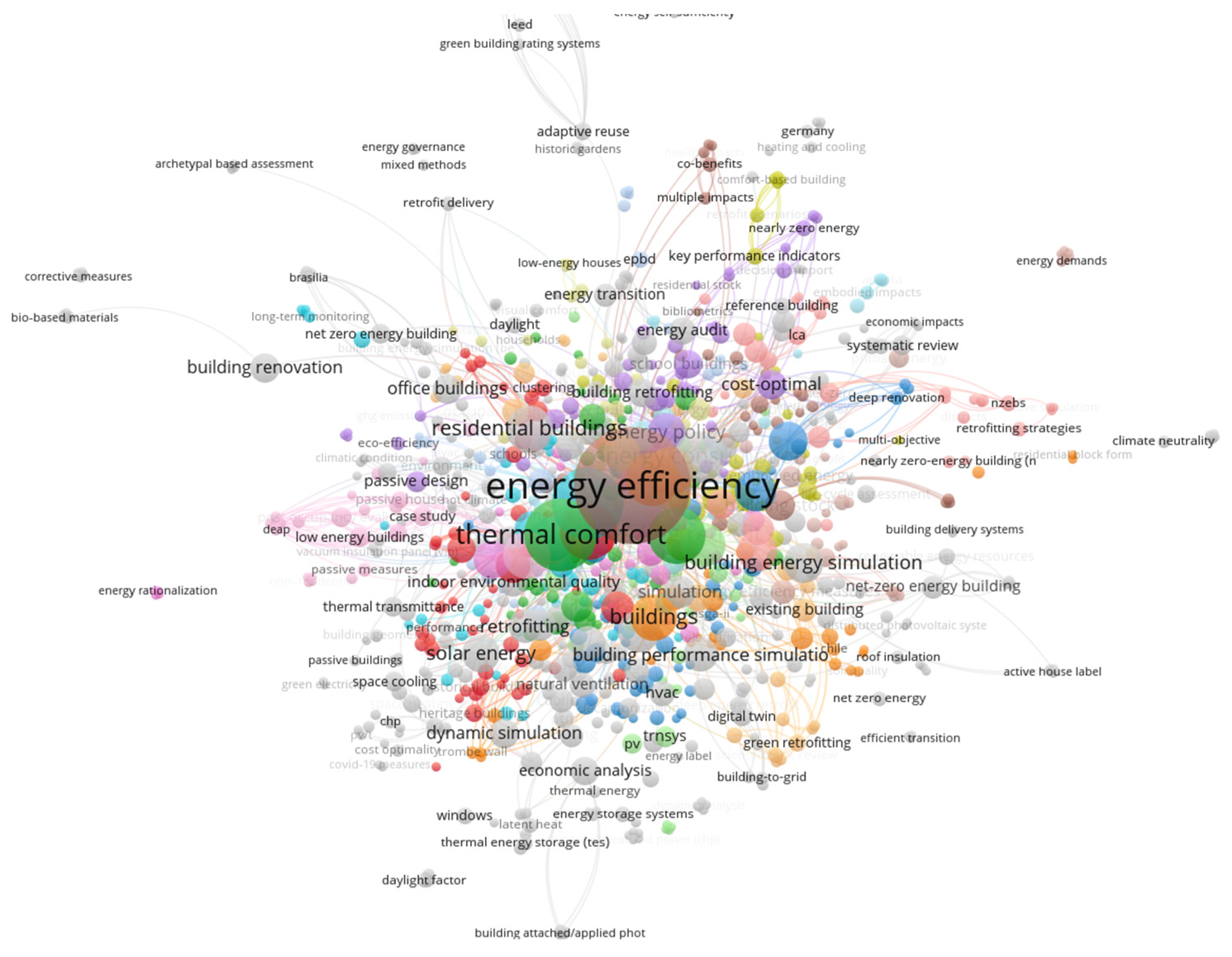

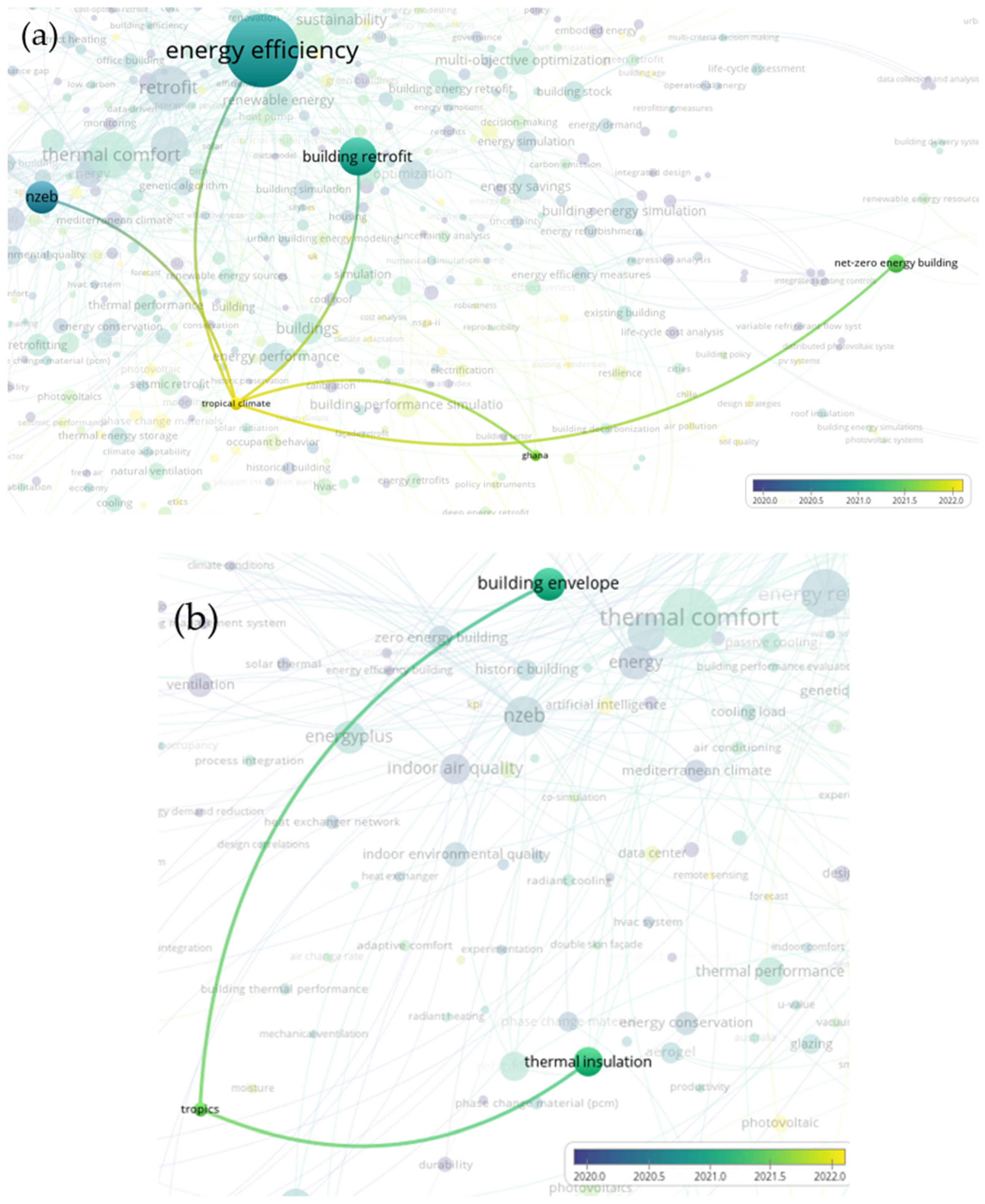
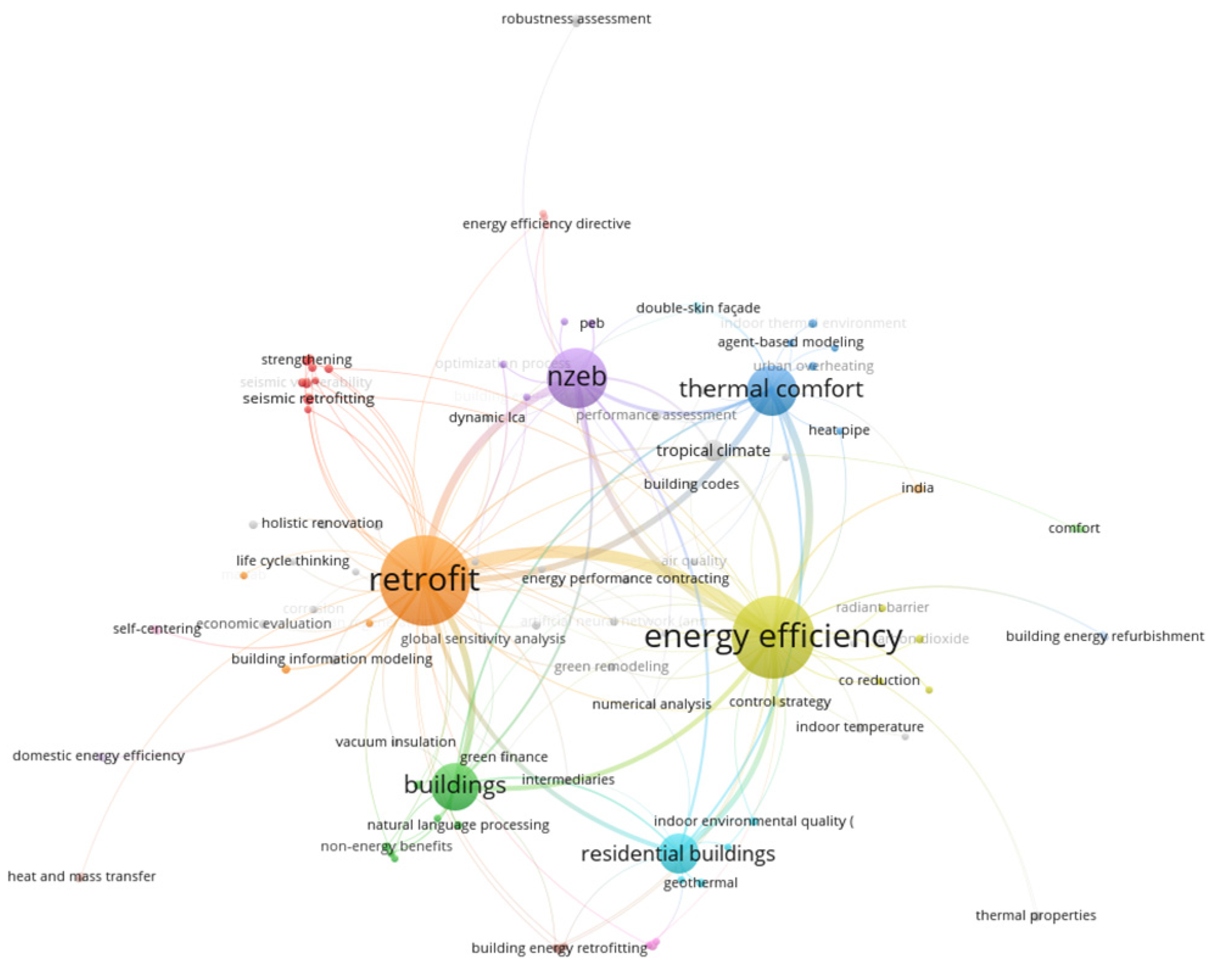
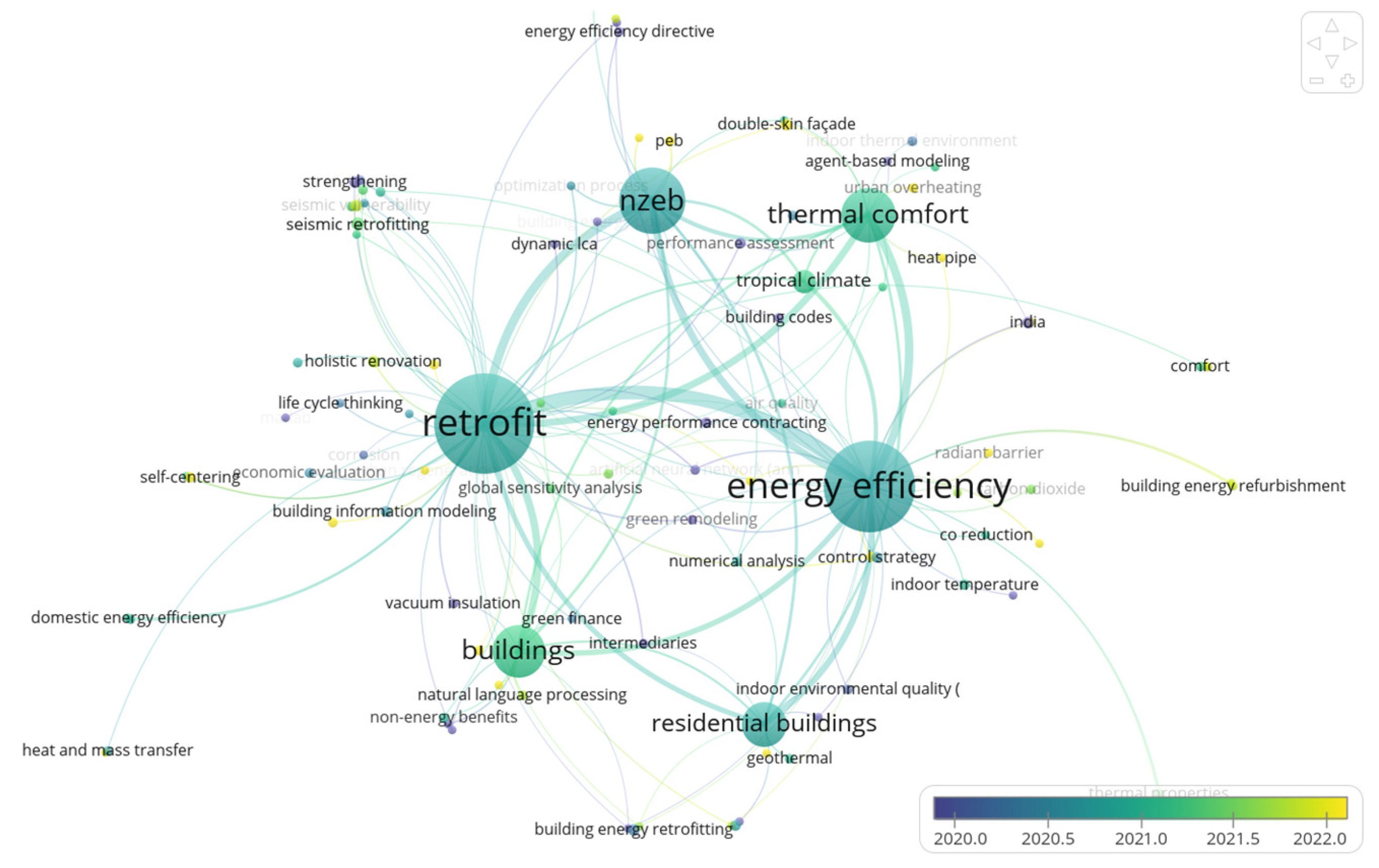
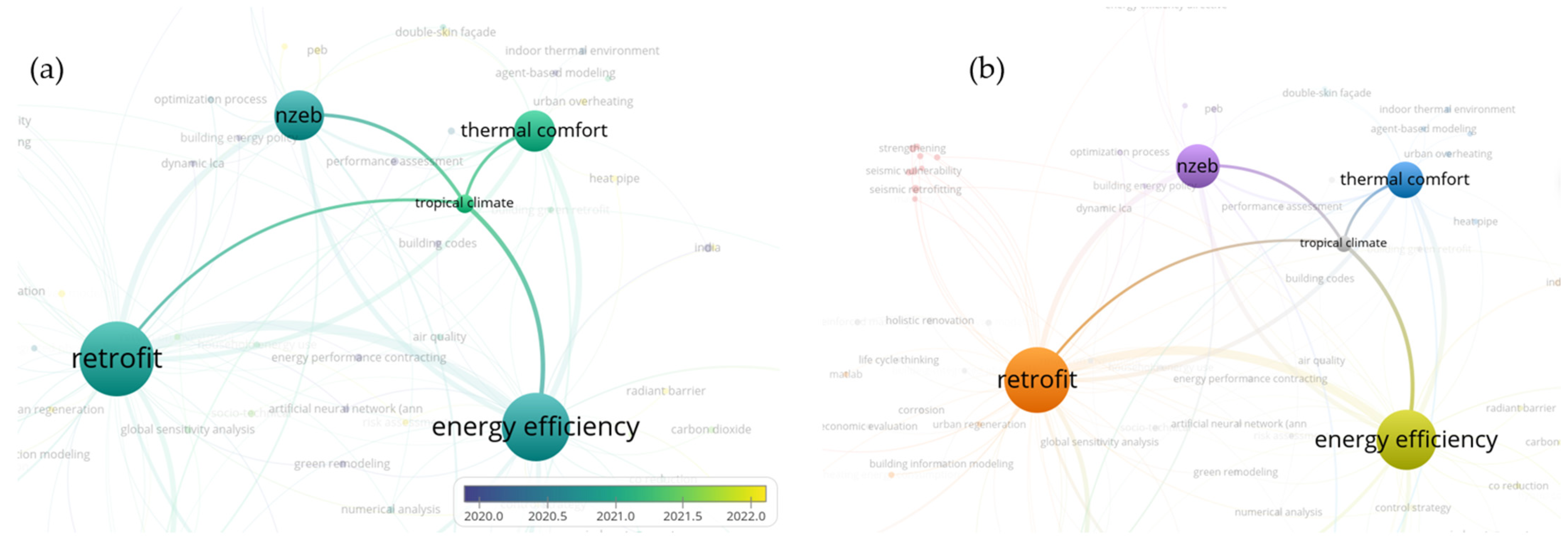

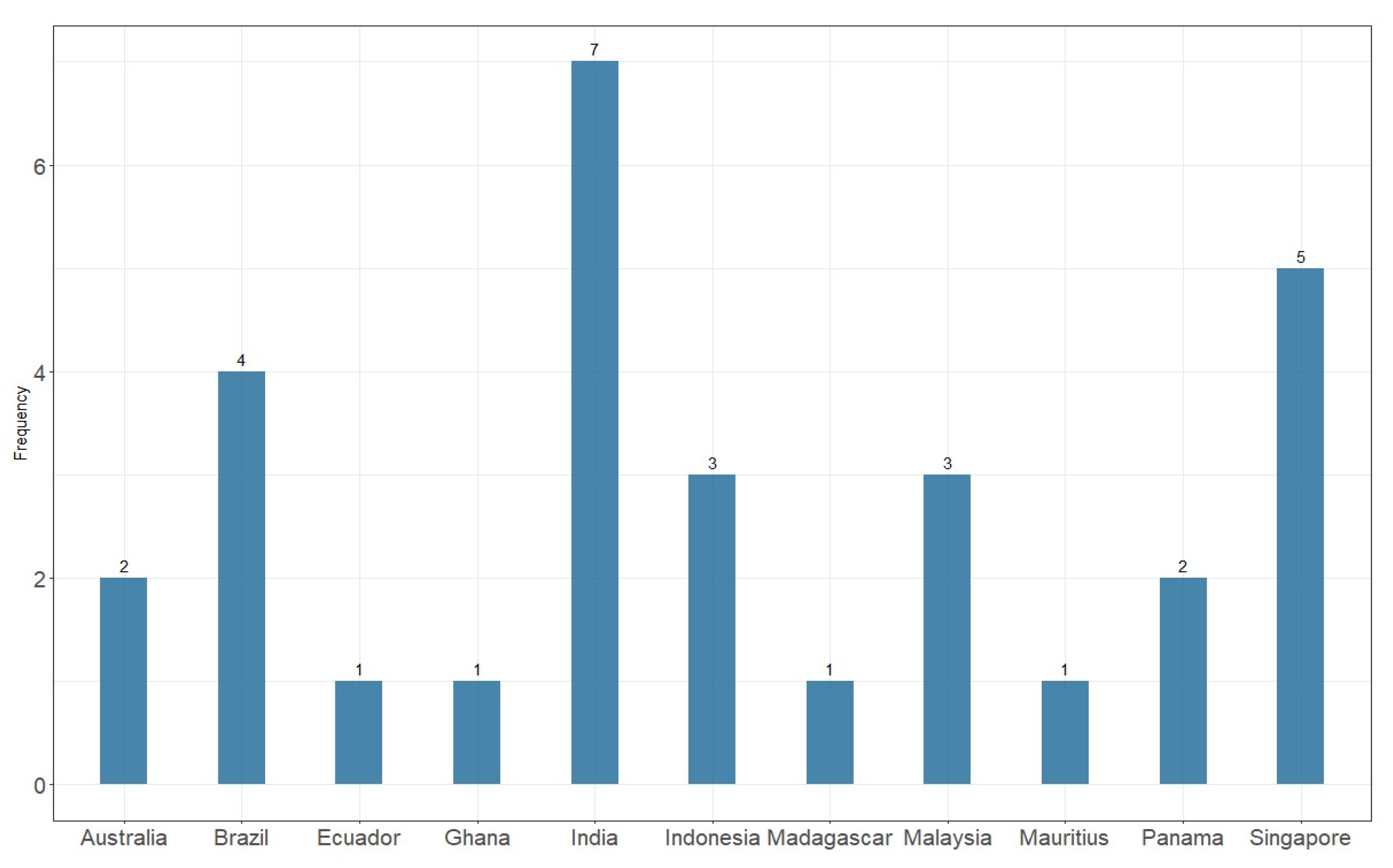
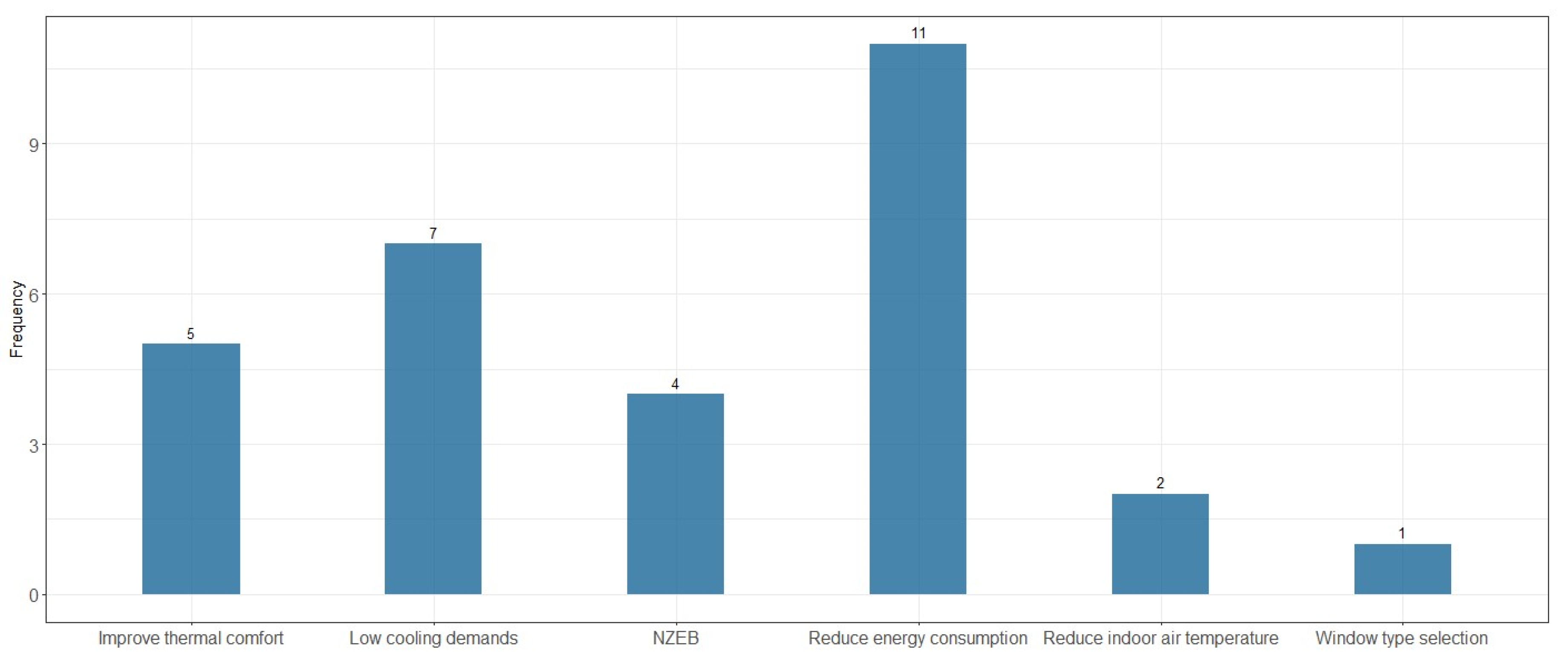

| Keywords | Number of Documents | Period |
|---|---|---|
| retrofit AND building AND “energy efficiency” | 10,299 | 2000–2024 |
| retrofit AND building AND “energy efficiency” AND (NZEB OR nZEB) | 753 | 2010–2024 |
| retrofit AND building | 22,672 | 2000–2024 |
| retrofit AND (NZEB OR nZEB) | 829 | 2010–2024 |
| retrofit AND building AND “energy efficiency” AND (tropics OR “tropical climate” OR humid) | 1444 | 2000–2024 |
| retrofit AND building AND “energy efficiency” AND (NZEB OR nZEB) AND (tropics OR “tropical climate” OR humid) | 166 | 2012–2024 |
| retrofit AND building AND (tropics OR “tropical climate” OR humid) | 2117 | 2000–2024 |
| retrofit AND (NZEB OR nZEB) AND (tropics OR “tropical climate” OR humid) | 178 | 2012–2023 |
| Keywords | Number of Documents | Period |
|---|---|---|
| retrofit AND building AND “energy efficiency” | 5107 | 2018–2024 |
| retrofit AND building AND “energy efficiency” AND (NZEB OR nZEB) | 504 | 2018–2023 |
| retrofit AND building | 10488 | 2018–2024 |
| retrofit AND (NZEB OR nZEB) | 550 | 2018–2024 |
| retrofit AND building AND “energy efficiency” AND (tropics OR “tropical climate” OR humid) | 812 | 2018–2024 |
| retrofit AND building AND “energy efficiency” AND (NZEB OR nZEB) AND (tropics OR “tropical climate” OR humid) | 130 | 2018–2023 |
| retrofit AND building AND (tropics OR “tropical climate” OR humid) | 1131 | 2018–2024 |
| retrofit AND (NZEB OR nZEB) AND (tropics OR “tropical climate” OR humid) | 138 | 2018–2023 |
| Keywords | Occurrence |
|---|---|
| energy efficiency | 762 |
| thermal comfort | 298 |
| retrofit | 282 |
| energy retrofit | 183 |
| building retrofit | 179 |
| climate change | 160 |
| energy consumption | 152 |
| sustainability | 129 |
| nzeb | 126 |
| buildings | 123 |
| residential buildings | 121 |
| renewable energy | 116 |
| energy saving | 111 |
| optimization | 108 |
| Keyword | Terms Grouped with the Keyword |
|---|---|
| buildings | building; building energy efficiency; building stock |
| energy efficiency | energy saving; energy performance; energy savings; building energy performance |
| nzeb | zero energy building; net-zero energy building; nearly zero energy building; net zero energy building; net-zero; nearly zero energy buildings; net zero energy buildings; net-zero energy buildings; zero energy buildings; nearly zero energy; nzebs; net zero energy; zeb; nearly zero energy building (nzeb); nearly zero-energy building (nzeb); nearly-zero energy buildings; net zero energy building (nzeb); net-zero buildings; near zero energy buildings; nearly zero energy buildings (nzebs); nearly zero energy buildings (nzebs); net-zero emissions buildings; net-zero energy rural house; nzeb target; near zero energy building; nearly-zero and positive energy paradigms; net zero energy buildings (nzebs); net-zero, ghg emissions; zero energy buildings (zebs); zero energy solar household; zero-carbon building; zero-energy targets; net-zero energy |
| PEB | positive energy buildings (pebs) |
| residential buildings | residential building; residential |
| retrofit | energy retrofit; building retrofit; seismic retrofit; retrofitting; building renovation; building energy retrofit; building retrofitting; existing buildings; existing building; renovation energy retrofits; refurbishment; green retrofit; building retrofits; energy-efficient retrofit; energy retrofitting; deep energy retrofit; green retrofitting; retrofits; building refurbishment; energy renovation; retrofit delivery; retrofit measures; retrofit scenarios; deep retrofit; retrofitting strategies; deep renovation; energy efficiency retrofit; home energy retrofit; rehabilitation; domestic retrofit; energetic retrofit; existing residentials; housing retrofit; passive energy-saving retrofit; retrofit double glazing; retrofit guidelines; retrofit market; sustainable building renovation; sustainable building upgrade; zero energy building renovation; building energy renovation; building energy retrofits; building envelope retrofits; cost-optimal retrofit; façade retrofit; retrofitting measures; social housing retrofit; sustainable retrofit; thermal retrofit; deep retrofitting; renovation strategies; residential building retrofit; retrofit interventions |
| thermal comfort | adaptive thermal comfort; indoor thermal comfort; outdoor thermal comfort |
| tropical climate | tropics; hot and humid climate; hot and humid climates; hot-humid climates; hot/warm and humid climates |
Disclaimer/Publisher’s Note: The statements, opinions and data contained in all publications are solely those of the individual author(s) and contributor(s) and not of MDPI and/or the editor(s). MDPI and/or the editor(s) disclaim responsibility for any injury to people or property resulting from any ideas, methods, instructions or products referred to in the content. |
© 2024 by the authors. Licensee MDPI, Basel, Switzerland. This article is an open access article distributed under the terms and conditions of the Creative Commons Attribution (CC BY) license (https://creativecommons.org/licenses/by/4.0/).
Share and Cite
Chung-Camargo, K.; González, J.; Chen Austin, M.; Carpino, C.; Mora, D.; Arcuri, N. Advances in Retrofitting Strategies for Energy Efficiency in Tropical Climates: A Systematic Review and Analysis. Buildings 2024, 14, 1633. https://doi.org/10.3390/buildings14061633
Chung-Camargo K, González J, Chen Austin M, Carpino C, Mora D, Arcuri N. Advances in Retrofitting Strategies for Energy Efficiency in Tropical Climates: A Systematic Review and Analysis. Buildings. 2024; 14(6):1633. https://doi.org/10.3390/buildings14061633
Chicago/Turabian StyleChung-Camargo, Katherine, Jinela González, Miguel Chen Austin, Cristina Carpino, Dafni Mora, and Natale Arcuri. 2024. "Advances in Retrofitting Strategies for Energy Efficiency in Tropical Climates: A Systematic Review and Analysis" Buildings 14, no. 6: 1633. https://doi.org/10.3390/buildings14061633







